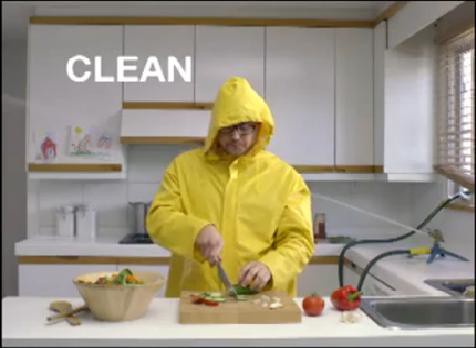Having trouble viewing this email? View it as a Web page.
You are subscribed to USDA Office of Communications.
USDA and other Federal public health partners launched Food Safe Families on June 28, the first national multimedia food safety campaign. Using the motto “Check Your Steps” (#checksteps on Twitter), Food Safe Families aims to get consumers to adopt four very easy steps when preparing food:
- Clean: Clean kitchen surfaces, utensils, and hands with soap and water while preparing food.
- Separate: Separate raw meats from other foods by using different cutting boards.
- Cook: Cook foods to the right temperature by using a food thermometer.
- Chill: Chill raw and prepared foods promptly.
USDA has been blogging on each of the steps each Tuesday and today’s subject was how to “Clean.” Last week we covered “Cook.”
We hope you will check with us the next two Tuesdays as we complete the series. Check them all out by going to the USDA Blog and looking for the “Check Your Steps” tag, or follow the link: http://blogs.usda.gov/tag/check-your-steps/
Posted by Agriculture Secretary Tom Vilsack, on June 28, 2011 at 9:34 AM

Clean, Separate, Cook, Chill: Food Safe Families simplifies and updates safe food handling recommendations to shift the way people think about food poisoning risk and prevention.
Today, USDA and the Department of Health and Human Services launched a true first for our departments and our nation’s public health system. USDA’s Food Safety and Inspection Service partnered with the Food and Drug Administration, the Centers for Disease Control and Prevention, and the Ad Council to debut a joint, national, multimedia public service campaign called Food Safe Families to help Americans prevent food-related illnesses in their homes. With this campaign, we’re trying to shift the way people think about food handling so they can take a more proactive, preventive approach at home to help reduce food-related illnesses.
The launch of the Food Safe Families campaign comes at a time when attention to food safety issues is high. This is also the start of summer and grilling season, when foodborne illnesses tend to increase with more outdoor meals and other factors that increase the risk for disease-causing bacteria in food. American families are looking for clear and concise information on how to better protect themselves, and this campaign has the potential to generate unprecedented national exposure to issues of food safety and foodborne illness prevention.
Using the motto “Check Your Steps” (#checksteps on Twitter), Food Safe Families aims to get consumers to adopt four very easy steps when preparing food:
- Clean: Clean kitchen surfaces, utensils, and hands with soap and water while preparing food.
- Separate: Separate raw meats from other foods by using different cutting boards.
- Cook: Cook foods to the right temperature by using a food thermometer.
- Chill: Chill raw and prepared foods promptly.
The campaign includes English and Spanish-language television, radio, print, and Web advertising, as well as an integrated social media program. All campaign elements direct audiences to visit FoodSafety.gov, a recently refreshed and updated site in English and Spanish, where they can learn about food safety practices. The program includes a new FoodSafety.gov Facebook page and outreach via the site’s Twitter handle, both emphasizing “Check Your Steps.” Consumers can also access “Ask Karen,” an online database with answers to nearly 1,500 food safety questions.
This Thursday, join @FoodSafetyGov and @USDAFoodSafety in a live Twitter Chat at 1:00 p.m. EDT, using the hashtag #checksteps to kick off the campaign and get answers to Fourth of July grilling questions.
Check Your Steps: Cook to Keep Your Family Safer from Food Poisoning
Posted by Diane Van, Manager of the USDA Meat & Poulty Hotline, on July 5, 2011 at 3:31 PM
While federal food safety agencies work hard every day to keep food safe before it gets to the consumer, the risk of foodborne illness has not been eliminated. One in six Americans will get food poisoning this year—that’s 48 million people. The USDA Meat & Poultry Hotline feels that it is important to give you information that can help prevent food poisoning when preparing meals at home.
Four simple behaviors—Clean, Separate, Cook, and Chill—are the focus of the new Food Safe Families campaign and can help you keep your family safe when preparing, serving and storing food. Have you seen our ad with a pig in a sauna, reminding Americans of the need to cook meat to the right temperature? We want consumers to understand that food poisoning can happen, and that there are ways to help prevent it.

The Food Safe Families campaign uses humorous public service announcements to capture the public’s attention about a very serious subject. The “cook” PSA reminds consumers to cook foods to the right temperature using a food thermometer.
Today and for the next three Tuesdays, we’ll post a blog focusing on one of these four important steps.
COOK
Always cook food to the right temperature.
The ONLY way to know when meats, poultry and seafood have reached a safe internal temperature is to use a food thermometer. You can’t tell by looking or by the color of meat or poultry.
Cook all raw beef, pork, lamb and veal steaks, chops, and roasts to a minimum internal temperature of 145 °F as measured with a food thermometer before removing meat from the heat source. For safety and quality, allow meat to rest for at least three minutes before carving or consuming. For reasons of personal preference, consumers may choose to cook meat to higher temperatures.
Cook all ground meat, including hamburgers, to 160 °F.
Cook all chicken and turkey—whole, pieces or ground—to 165 °F.
Reheat leftovers to 165 °F.
Always place the food thermometer in the thickest part of the food, away from bone and fat, to check the temperature.
Use a food thermometer to check the internal temperature of the food in several places.
When cooking in a microwave oven, stir, cover, and rotate food for even cooking. Let food rest for a few minutes after cooking it in the microwave. This helps your food cook more completely by allowing colder areas of food time to absorb heat from hotter areas of food.
More information can be found here to make sure you’re cooking different types of food and using kitchen appliances properly to keep your family safe. Follow #checksteps on Twitter or visit www.Facebook.com/foodsafety.gov for updates from the Food Safe Families campaign.
Check Your Steps! Clean: Wash Hands and Surfaces Often to Keep Your Family Safer from Food Poisoning
Posted by Diane Van, Deputy Director of the Food Safety Education Staff, USDA Food Safety and Inspection Service, on July 12, 2011 at 9:58 AM
Bacteria exist everywhere in our environment, and some of them can make us really sick. Illness-causing bacteria exist in or on food, on countertops, kitchen utensils, hands, pets, and in the dirt where food grows. As part of the Food Safe Families campaign, this week’s Check Your Steps blog focuses on cleaning before, during, and after preparing and eating food to keep your family safer from food poisoning.

The Food Safe Families campaign uses humorous public service announcements to capture the public’s attention about a very serious subject. The “clean” PSA reminds consumers to clean kitchen surfaces, utensils, and hands with soapy water.
Can I just rinse my hands?
Washing your hands is important, and not just during flu season. Pathogens like E. coli can be passed from person to person, so wash—don’t just rinse—your hands for twenty seconds with running water and soap at these key times:
- Before and after handling food
- After playing with pets
- After using the bathroom
- After changing diapers
Do I have to wash the food I’m going to peel anyway?
Because it’s easy to transfer bacteria from the peel or rind while you’re cutting your fruits and veggies, wash all produce, even if you plan to peel it. Scrub melons, cucumbers and other firm produce with a produce brush before slicing. Skip soap or detergent—these can leave behind residue that you don’t want to ingest. Using clean running water is the safest way to remove bacteria and wash produce.
Will washing raw chicken make it safer?
No! Rinsing meat, poultry or seafood with water increases your chance of food poisoning by splashing juices – and any bacteria they might contain – onto your sink and counters. The best way to cook meat, poultry or seafood safely is to cook it to the right temperature.
How clean is clean enough?
You may have seen this video showing what overzealous cleanliness in the kitchen looks like. In reality, we don’t recommend using a sprinkler to keep your kitchen clean!
Kitchens and dining areas have many surfaces that come into contact with food. Utensils like spatulas, knives, small cutting boards and food thermometers should be washed with hot, soapy water after each use. Dish cloths go in the washing machine. Flood countertops and large cutting boards with one teaspoon of unscented liquid bleach per quart of water (there is no advantage to using more bleach), and let it stand for ten minutes. Rinse with clean water, and let the surfaces air dry or pat them dry with fresh paper towels.
For more information on cleanliness in the kitchen go here. Check back every Tuesday for another Check Your Steps blog post (last week’s focused on “Cook”), and follow #checksteps on Twitter for updates on the Food Safe Families campaign.
